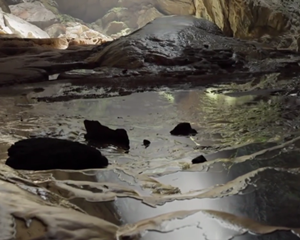This is the entrance to one of the greatest of natural wonders.
这里是通往最伟大自然奇观之一的入口。
Hang Son Doong, in Vietnam. It's thought to be the largest cave on Earth.
越南韩松洞。这里被认为是地球上最大的洞穴。
Here, 200 metres underground, for just a few weeks a year, sunbeams cast light through a hole in the cave's roof.
深达200米,一年中只有几周时间阳光能透过洞顶的缝隙,照射入内。
There is just enough light to enable plants to grow.
这点阳光刚好能满足植物的生长。
But travel deeper, and darkness returns.
随着继续深入,黑暗再次笼罩。
And you reach the limit of where life can exist.
这里的极端环境下,生命如履薄冰。
These most extreme places on our planet are often hard for us to reach.
人类通常难以涉足这些地球上最极端的环境。
Indeed, this cave was only recently discovered. And it contains many surprises.
事实上,这个洞穴是最近才被发现的。其中蕴藏着许多惊喜。

Cave pearls. Once tiny sand grains, now spheres the size of tennis balls.
洞穴珍珠。曾经微小的沙粒,如今足有网球大小。
And giant stalagmites formed over centuries by billions of individual drops of water.
巨大的石笋,数百年来由几十亿滴水日积月累而成。
Underground rivers have carved this great passage through the limestone.
地下河在石灰岩中开辟了这条巨大的水道。
Over five miles long, and wide enough in places to accommodate a jumbo jet.
长度超过8公里,宽度足以容纳一架大型喷气式飞机。
And it is here, in the cave's furthest chamber, that life can be found.
而就在这里,洞穴的最深处,孕育着生命。
Translucent cave fish and shrimps.
半透明洞穴鱼,洞穴虾。
Isolated for millennia, feeding on little more than the nutrients from the jungle above.
几千年来与世隔绝,仅以头顶丛林里的营养物质为生。
The fish are completely blind and find their way about by touch alone.
洞穴鱼没有视觉,只能依靠触觉辨认方向。
These underground worlds are at the very limit of where life can exist.
在这些地下世界中,生命如履薄冰。












